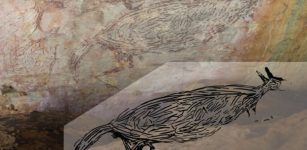Mystery Of Ancient Language PIE From Which Half Of All Languages Originate
Ellen Lloyd - AncientPages.com - Did you know that about three billion people speak languages that all originate from one root language that was spoken about 6,000 years ago?
Ancient language PIE is not a universal language, but it is the common ancestor of the Indo-European languages, the world's most widely spoken language family. As many as 400 languages and dialects originate from it.
Hindi, Bengali, Persian, English, German, Spanish, and Greek all come from the same root, known as Proto-Indo-European (PIE).
Proto-Indo-European, or PIE, was discovered in 1868 by German linguist August Schleicher.
When And Where Was PIE First Spoken?
It remains unknown when, where, and by whom PIE was spoken, and scholars disagree on how the language spread.
However, many theories attempt to unravel the mystery of this fascinating ancient language.
Currently, the Kurgan hypothesis is the most accepted theory according to which language PIE formed in a region known as the Pontic-Caspian Steppe, a sprawling grassland north of the Black and Caspian Seas today encompasses parts of Russia, Ukraine, and Kazakhstan. The earliest Kurgans date to the 4th millennium BC in the Caucasus and are associated with the Indo-Europeans.
Language PIE is believed to have been spoken in the region from about 4500 to 2500 B.C. Linguist Will Chang from UC Berkeley conducted a comprehensive study of the Proto-Indo-European language and discovered that the first linguistic divergence occurred about 6,500 years ago. By cross-referencing these findings with an analysis of the Indo-European language tree, Chang and colleagues concluded that conquering Indo-Europeans spread PIE as they moved westward.
The Kurgan hypothesis has also been confirmed by David Reich of Harvard University. Reich examined 69 ancient Eurasian mummies who lived 8,000 to 3,000 years ago. One of the mummies was the famous Iceman Ötzi discovered in a 5,000-year-old glacier in the Ötzal Alps in South Tyrol. Genetic tests revealed that certain ailments, including hay fever, derive from Neanderthal genes.
Based on these results, scientists could conclude that European hunter-gatherers came from the Yamnaya steppe in Russia, appearing around 6,000 to 5,000 years ago. These herders originated in the Near East.
Later, about 4,500 years ago, the Corded Ware people created settlements in the Northern part of Europe, including Germany. According to the genetic study conducted by Reich, the Yamnaya Steppe people swept through from the East, settling in Europe and eventually becoming the Corded Ware people. Genetic evidence suggests that most Europeans can trace their ancestry to the Corded Ware people.
Another theory also attempts to explain the origin of the PIE language. According to the Anatolian hypothesis that was first developed by British archaeologist Colin Renfrew in 1987 and later supported by evolutionary biologists from the University of Auckland, New Zealand, speakers of the Proto-Indo-European language (PIE) lived in Anatolia during the Neolithic era, beginning about 10,200 BC, and ending between 4500 and 2000 BC.
The Kurgan and Anatolian hypotheses contradict each other, but scientists seriously consider both since they offer compelling evidence.
Scientists also consider the possibility there is one common universal language that ties all other languages together.
The idea of a universal human language goes back at least to the Bible, in which humanity spoke a common tongue but was punished with mutual unintelligibility after trying to build the Tower of Babel all the way to heaven.
Some researchers think they have found a universal language that self-organizes so that related concepts stay as close together as possible within a sentence, making it easier to piece together the overall meaning.
Updated on August 3, 2024
Written by Ellen Lloyd – AncientPages.com
Copyright © AncientPages.com All rights reserved. This material may not be published, broadcast, rewritten or redistributed in whole or part without the express written permission of AncientPages.com
Expand for referencesMore From Ancient Pages
-
 Puzzle Of The Bull Rock Cave – Ancient Mass Grave Remains Unexplained
Featured Stories | Mar 12, 2018
Puzzle Of The Bull Rock Cave – Ancient Mass Grave Remains Unexplained
Featured Stories | Mar 12, 2018 -
 Egyptian Necropolis Of Asyut And Funerary Culture That Dates Back To Old Kingdom
Archaeology | Feb 24, 2020
Egyptian Necropolis Of Asyut And Funerary Culture That Dates Back To Old Kingdom
Archaeology | Feb 24, 2020 -
 Exploring Future Evolution: How Will Humans Change In The Next 10,000 Years?
Featured Stories | Oct 3, 2022
Exploring Future Evolution: How Will Humans Change In The Next 10,000 Years?
Featured Stories | Oct 3, 2022 -
 Count Dracula: His Letters Helped Researchers Cast New Light On Health Of Legendary Figure
Historical Figures | Aug 17, 2023
Count Dracula: His Letters Helped Researchers Cast New Light On Health Of Legendary Figure
Historical Figures | Aug 17, 2023 -
 8-Year-Old Boy Finds Unusual Viking Age Artifact On Gotland Island, Sweden
Archaeology | Sep 18, 2023
8-Year-Old Boy Finds Unusual Viking Age Artifact On Gotland Island, Sweden
Archaeology | Sep 18, 2023 -
 Ancient Temple At Taposiris Magna In Alexandria, Egypt, Reveals Some Of Its Secrets
Archaeology | Dec 18, 2024
Ancient Temple At Taposiris Magna In Alexandria, Egypt, Reveals Some Of Its Secrets
Archaeology | Dec 18, 2024 -
 Ship-Shaped Burial Of Tjelvar – Legendary First Man Who Brought Fire To Gotland
Featured Stories | Feb 25, 2021
Ship-Shaped Burial Of Tjelvar – Legendary First Man Who Brought Fire To Gotland
Featured Stories | Feb 25, 2021 -
 Australia’s Two-Meter-Long And Oldest Known Rock Painting Of A Kangaroo – Revealed
News | Feb 23, 2021
Australia’s Two-Meter-Long And Oldest Known Rock Painting Of A Kangaroo – Revealed
News | Feb 23, 2021 -
 On This Day In History: Admiral Richard E. Byrd Made His First Flight Over The South Pole – On Nov 29, 1929
News | Nov 29, 2016
On This Day In History: Admiral Richard E. Byrd Made His First Flight Over The South Pole – On Nov 29, 1929
News | Nov 29, 2016 -
 Coricancha – Stunning Golden Garden And Lost Treasures Of The Inca
Featured Stories | Aug 20, 2021
Coricancha – Stunning Golden Garden And Lost Treasures Of The Inca
Featured Stories | Aug 20, 2021 -
 Has The Mystery Of Cerne Abbas Giant Been Solved?
Archaeology | Jan 2, 2024
Has The Mystery Of Cerne Abbas Giant Been Solved?
Archaeology | Jan 2, 2024 -
 ‘Completely Unique’ Seal Matrix Found Near Norwich, UK
Archaeology | Dec 1, 2023
‘Completely Unique’ Seal Matrix Found Near Norwich, UK
Archaeology | Dec 1, 2023 -
 17 Mysterious Miniature Coffins In Scotland Remain An Unsolved Enigma
Artifacts | Feb 24, 2018
17 Mysterious Miniature Coffins In Scotland Remain An Unsolved Enigma
Artifacts | Feb 24, 2018 -
 3,800-Year-Old Wall Relief Created By Ancient Caral People Unearthed In Peru
Archaeology | Aug 28, 2018
3,800-Year-Old Wall Relief Created By Ancient Caral People Unearthed In Peru
Archaeology | Aug 28, 2018 -
 Could Neanderthals Meditate? Scientists Investigate
Archaeology | Jun 30, 2022
Could Neanderthals Meditate? Scientists Investigate
Archaeology | Jun 30, 2022 -
 Sun: Highest Cosmic Power Worshiped By Ancient People And Represented By Deities
Featured Stories | Apr 1, 2019
Sun: Highest Cosmic Power Worshiped By Ancient People And Represented By Deities
Featured Stories | Apr 1, 2019 -
 How Did A Roman Sarcophagus End Up On A Beach Near Varna In Bulgaria?
Archaeology | Aug 6, 2024
How Did A Roman Sarcophagus End Up On A Beach Near Varna In Bulgaria?
Archaeology | Aug 6, 2024 -
 Biblical Vineyard Of Naboth Existed And Has Been Found
Archaeology | Aug 3, 2017
Biblical Vineyard Of Naboth Existed And Has Been Found
Archaeology | Aug 3, 2017 -
 Resourceful Neanderthals Could Dive 13ft If Necessary To Collect Shells
Archaeology | Jan 16, 2020
Resourceful Neanderthals Could Dive 13ft If Necessary To Collect Shells
Archaeology | Jan 16, 2020 -
 Medieval Pilgrim’s Badge (‘Pilgrim’s Sign’) Depicting A Basilisk Dragon In A Circle Discovered In Southeastern Poland
Artifacts | Mar 5, 2024
Medieval Pilgrim’s Badge (‘Pilgrim’s Sign’) Depicting A Basilisk Dragon In A Circle Discovered In Southeastern Poland
Artifacts | Mar 5, 2024


